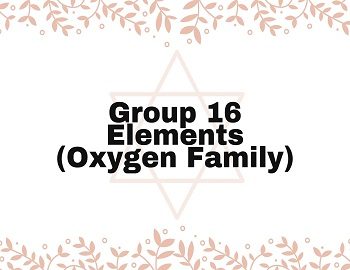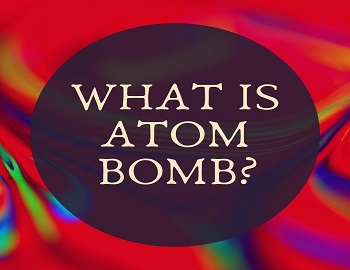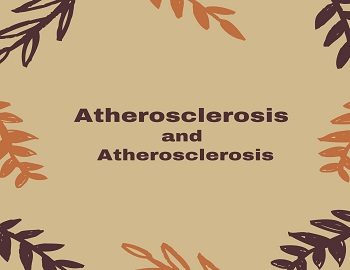Oxygen Family:
The elements Oxygen (O), Sulfur (S), Selenium (Se), Tellurium (Te) and Polonium (Po) together constitute group 16 of the long form of Periodic table and are collectively referred to as Members of “Oxygen Family”. These elements are also known as Chalcogens (meaning “Ore forming”) because most of these elements exist in the form of ores. The last member, i.e. Po, is radioactive in nature with a very short half-life period.
General Trends in Physical Properties of Oxygen Family:
(i) Electronic Configuration- The general outer electronic configuration of the members of the oxygen family is ns2 np4 (n = 2 to 6) indicating that these elements have six electrons in the valence shell (2 in s-orbital and 4 in p-orbitals).
| Element / Symbol | Atomic Number | Electronic Configuration |
|---|---|---|
| Oxygen, O | 8 | 1s2, 2s2 2p4 or [He] 2s2 2p4 |
| Sulfur, S | 16 | 1s2, 2s2 2p6, 3s2 3p4 or [Ne] 3s2 3p4 |
| Selenium, Se | 34 | 1s2, 2s2 2p6, 3s2 3p6 3d10, 4s2 4p4 or [Ar] 3d10, 4s2 4p4 |
| Tellurium, Te | 52 | 1s2, 2s2 2p6, 3s2 3p6 3d10, 4s2 4p6 4d10, 5s2 5p4 or [ Kr] 4d10, 5s2 5p4 |
| Polonium, Po | 84 | 1s2, 2s2 2p6, 3s2 3p6 3d10, 4s2 4p6 4d10 4f14, 5s2 5p6 5d10, 6s2 6p4 or [Xe] 4f14, 5d10, 6s2 6p4 |
(ii) Physical State- Oxygen is a colourless diatomic gas while other members are solids.
(iii) Density- The densities of elements of group 16 increases gradually on moving down the group from ‘O’ to ‘Po’ due to increase in atomic mass which dominates the effect of increase in atomic size.
(iv) Atomic radii and Ionic radii- The elements of group 16 have small values of atomic radii because of their high nuclear charge. However, on moving down the group from ‘O’ to ‘Po’, there is an increase in atomic radii with the increase in atomic number due to an increase in the number of inner energy levels. Like atomic radii, ionic radii also shows an increasing trend in moving down the group.
(v) Melting points and Boiling points- The melting points and boiling points of elements of group 16 gradually increases on moving down the group. The melting point and boiling point of Po are, however, less than that of Te.
(vi) Electronegativity- The members of group 16 have high values of electronegativity because of their small atomic size. Oxygen, the first member of the family has maximum electronegativity in its group (3.5) and it shows a decreasing trend on moving down the group due to increase in atomic size as a valence shell electrons decrease.
(vii) Ionisation energy- The elements of group 16 have quite high values of ionisation energy because of their small atomic size. However, on moving down the group from ‘O’ to ‘Po’, ionisation energy shows a decreasing trend due to increase in atomic size and screening effect which causes decrease in the forces of attraction between nucleus and valence shell electrons.
(viii) Molecular Structure- Oxygen exists as diatomic (O2) gaseous molecule while other members are solid, and have a complex molecular structure. Example- ‘S’ and ‘Se’ exist as octa-atomic molecules (S8 and Se8) which form a puckered type of ring structures.
(ix) Catenation- Oxygen and sulfur show the property of catenation though to a very little extent and it further decreases on moving down the group from ‘O’ to ‘Po’.
O = O ——(O2)
H – O – O – H ——–(H2O2)
H – S – S – S – S – H ————-(H2S4)
(x) Oxidation States- The electronic configuration of these elements (ns2 np4) shows that they require two electrons to attain the stable electronic configuration which they attain either by gaining or by sharing two electrons with other elements. Thus, these elements show both positive and negative oxidation states-
- Negative Oxidation States- The tendency to show negative oxidation states decreases on moving down the group due to a decrease in electronegativity. Oxygen being most electronegative in its group acquires stable configuration by gaining two electrons and thus forms dinegative ions (O2-) thereby exhibiting -2 oxidation state most commonly. However, it also exhibits an oxidation state of -1 in Peroxides (Na2O2, H2O2 etc.). Sulfur also shows -2 oxidation state in some of its compounds. Example- Na2S, H2S etc. The other members of the family hardly show any tendency to exhibit negative oxidation states.
- Positive Oxidation States- The only positive oxidation state shown by ‘O’ is +2 in OF2 (oxygen difluoride) because of the high electronegativity of F (4.0) than that of oxygen (3.5). The other members of the family (S, Se, Te) because of their comparatively lower electrovities and presence of vacant d-orbitals in their valence shell can show positive oxidation states of +2, +4 and +6. Example- SO2 (+4), SO3 (+6), SeF4 (+4), SeF6 (+6), TeBr4 (+4), TeF6 (+6) etc. The +4 oxidation state is shown when only p-electrons are unpaired and promoted to vacant d-orbital while +6 oxidation state is shown when both s and p electrons are promoted to the vacant d-orbitals of the valence shell. Oxygen does not show higher oxidation states due to the absence of vacant d-orbitals in its valence shell.









Comments (No)